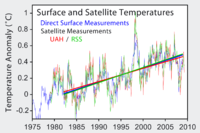Microwave Sounding Unit temperature measurements refers to temperature measurement using the Microwave Sounding Unit instrument and is one of several methods of measuring Earth atmospheric temperature from satellites. Microwave measurements have been obtained from the troposphere since 1979, when they were included within NOAA weather satellites, starting with TIROS-N. By comparison, the usable balloon (radiosonde) record begins in 1958 but has less geographic coverage and is less uniform.
Microwave brightness measurements do not directly measure temperature. They measure radiances in various wavelength bands, which must then be mathematically inverted to obtain indirect inferences of temperature.[1][2] The resulting temperature profiles depend on details of the methods that are used to obtain temperatures from radiances. As a result, different groups that have analyzed the satellite data have obtained different temperature trends. Among these groups are Remote Sensing Systems (RSS) and the University of Alabama in Huntsville (UAH). The satellite series is not fully homogeneous – the record is constructed from a series of satellites with similar but not identical instrumentation. The sensors deteriorate over time, and corrections are necessary for satellite drift in orbit. Particularly large differences between reconstructed temperature series occur at the few times when there is little temporal overlap between successive satellites, making intercalibration difficult.
- ^ "Atmospheric Soundings". Issues in the Integration of Research and Operational Satellite Systems for Climate Research: Part I. Science and Design. Washington, D.C.: National Academy Press. 2000. pp. 17–24. doi:10.17226/9963. ISBN 978-0-309-51527-6.
- ^ Uddstrom, Michael J. (1988). "Retrieval of Atmospheric Profiles from Satellite Radiance Data by Typical Shape Function Maximum a Posteriori Simultaneous Retrieval Estimators". Journal of Applied Meteorology. 27 (5): 515–549. Bibcode:1988JApMe..27..515U. doi:10.1175/1520-0450(1988)027<0515:ROAPFS>2.0.CO;2.

